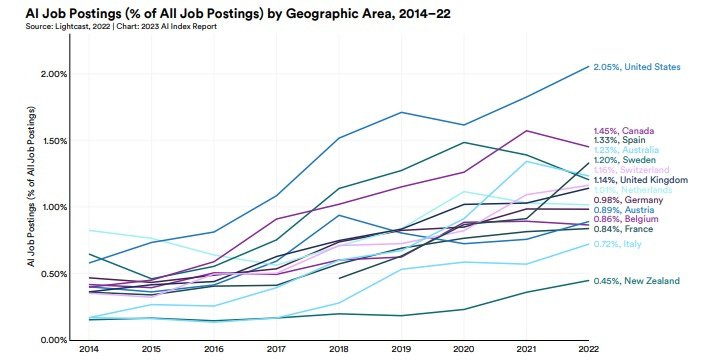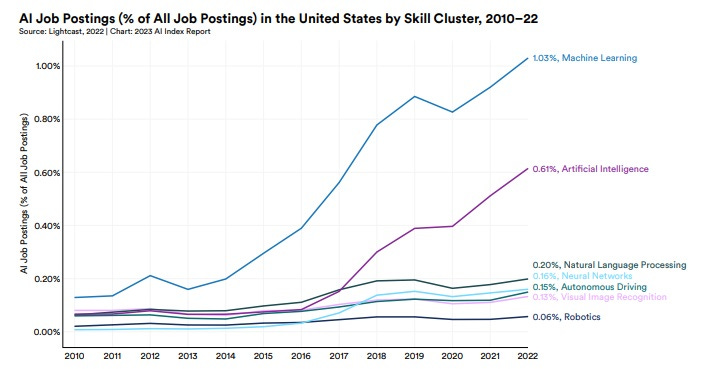🦋 As AI-machine learning emerges, Americans' doubts grow
You know who's super-positive about AI, however? The Chinese. Think about it.
You can count conservative columnist Peggy Noonan as the latest AI doomer. From her recent column: “Of course AI’s development should be paused, of course there should be a moratorium, but six months won’t be enough. Pause it for a few years. Call in the world’s counsel, get everyone in. Heck, hold a World Congress.”
I don’t really know how any of that would work — I think there’s currently a World Esperanto Congress and World Cat Congress, and I’m guessing a World AI Congress would be about as effective as the former and organized at the latter — just like I am pretty sure most pundits don’t know how any of these emerging AI and machine learning technologies work. But I’m sure the debate will continue to rage on social media about whether generative AI, in particular, is such a potential threat to humanity that we should either pause further training of Large Language Models — or even impose a moratorium under threat of military action.
Meanwhile, most scientists, technologists, entrepreneurs, business execs, and investors continue to play their part in this exciting, emerging technology of vast potential. So here are a few of the key takeaways from the just-released AI Index 2023 Annual Report by Stanford University’s Human-Centered Artificial Intelligence project. For the moment, I’m going to focus on the data and trends that will be important to push AI/ML forward while also getting the technology broadly and deeply diffused throughout the American economy. From the report:
AI research is on the rise, across the board. The total number of AI publications has more than doubled since 2010. The specific AI topics that continue dominating research include pattern recognition, machine learning, and computer vision.
Industry races ahead of academia. Until 2014, most significant machine learning models were released by academia. Since then, industry has taken over. In 2022, there were 32 significant industry-produced machine learning models compared to just three produced by academia.
Large language models are getting bigger and more expensive. GPT-2, released in 2019, considered by many to be the first large language model, had 1.5 billion parameters and cost an estimated $50,000 USD to train. PaLM, one of the flagship large language models launched in 2022, had 540 billion parameters and cost an estimated $8 million USD—PaLM was around 360 times larger than GPT-2 and cost 160 times more.
The world’s best new scientist … AI? AI models are starting to rapidly accelerate scientific progress and in 2022 were used to aid hydrogen fusion, improve the efficiency of matrix manipulation, and generate new antibodies.
AI starts to build better AI. Nvidia used an AI reinforcement learning agent to improve the design of the chips that power AI systems. Similarly, Google recently used one of its language models, PaLM, to suggest ways to improve the very same model. Self-improving AI learning will accelerate AI progress.
The demand for AI-related professional skills is increasing across virtually every American industrial sector. Across every sector in the United States for which there is data (with the exception of agriculture, forestry, fishing, and hunting), the number of AI-related job postings has increased on average from 1.7% in 2021 to 1.9% in 2022. Employers in the United States are increasingly looking for workers with AI-related skills.
Once again, the United States leads in investment in AI. The U.S. led the world in terms of total amount of AI private investment. In 2022, the $47.4 billion invested in the U.S. was roughly 3.5 times the amount invested in the next highest country, China ($13.4 billion). The U.S. also continues to lead in terms of total number of newly funded AI companies, seeing 1.9 times more than the European Union and the United Kingdom combined, and 3.4 times more than China.
More and more AI specialization. The proportion of new computer science PhD graduates from U.S. universities who specialized in AI jumped to 19.1% in 2021, from 14.9% in 2020 and 10.2% in 2010.The U.S. government continues to increase spending on AI. Since 2017, the amount of U.S. government AI-related contract spending has increased roughly 2.5 times
The U.S. government continues to increase spending on AI. Since 2017, the amount of U.S. government AI-related contract spending has increased roughly 2.5 times
Keep reading with a 7-day free trial
Subscribe to Faster, Please! to keep reading this post and get 7 days of free access to the full post archives.




